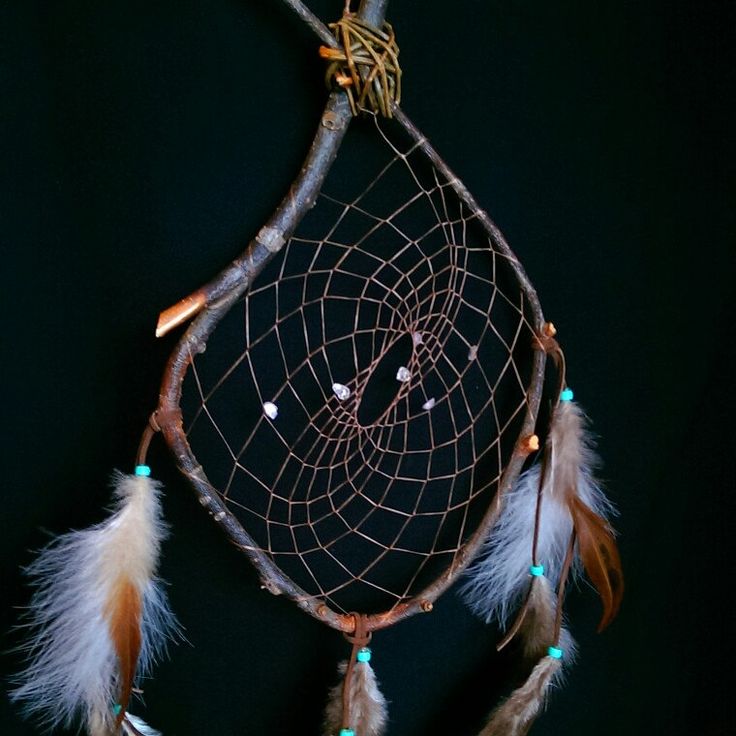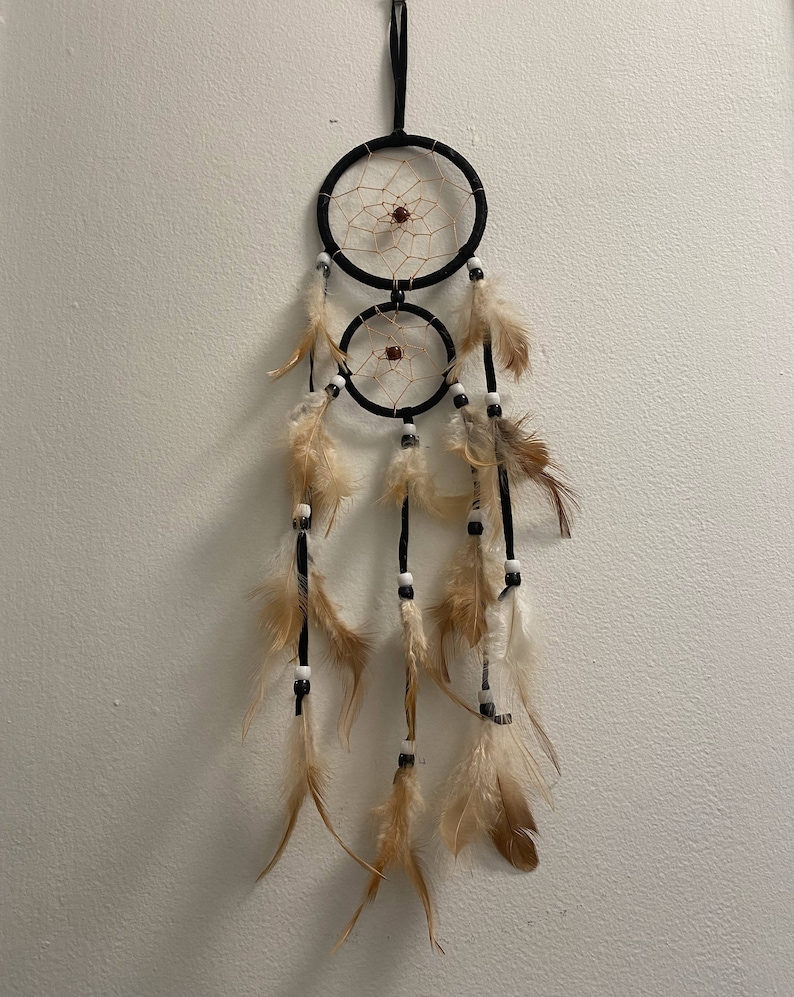
Whispers of Willow and Web: Unraveling the True Materials of the Ojibwe Dreamcatcher
The dreamcatcher, a ubiquitous symbol of comfort and protection, dangles from rearview mirrors, adorns walls in countless homes, and is a staple in souvenir shops worldwide. Its intricate web and hanging feathers evoke a sense of mystique and connection to a world beyond our waking hours. Yet, for many, the modern dreamcatcher is a far cry from its origins. To truly understand this powerful cultural artifact, one must look beyond the mass-produced trinkets and delve into the traditional materials and profound spiritual significance bestowed upon it by its originators: the Anishinaabe people, specifically the Ojibwe (also known as Chippewa) Nation.
The journey into the authentic dreamcatcher begins not with plastic hoops and synthetic feathers, but with the earth itself – with the humble willow branch, the resilient sinew, the delicate feathers of specific birds, and the carefully chosen beads. Each component was not merely decorative; it was imbued with purpose, symbolism, and a deep respect for the natural world from which it sprang.
The Sacred Circle: Willow (Wiigwaas)

At the heart of every traditional Ojibwe dreamcatcher is the hoop, typically crafted from a freshly cut willow branch. Willow, known as wiigwaas in Ojibwemowin, is not chosen arbitrarily. It is a sacred tree, revered for its flexibility, resilience, and its ability to bend without breaking – qualities that mirror the strength and adaptability necessary for life’s journey.
"The willow is more than just a branch; it represents the circle of life, the continuous flow of the sun and moon, and the never-ending cycle of nature," explains an elder’s teaching often shared within the Ojibwe community. The branches are carefully selected in spring when they are pliable and full of life. They are then gently bent into a perfect circle, often while still green, and tied to maintain their shape as they dry. This natural, organic form stands in stark contrast to the rigid, often metal or plastic hoops found in commercial versions. The slight imperfections and natural variations of the willow hoop are not flaws but testaments to its authentic origins and the hand that shaped it.
The Protective Web: Sinew and Plant Fibers (Azaadi-bimaagan)
Within the willow hoop, the intricate web is woven. Traditionally, this web was crafted from animal sinew – typically from deer or moose – or from natural plant fibers such as nettle or basswood bark. The preparation of these materials was a labor-intensive process, requiring patience and skill. Animal sinew would be cleaned, dried, and then painstakingly separated into fine, strong threads. Plant fibers, like those from the stinging nettle, would be processed through retting (soaking in water) to separate the fibers, which were then dried, twisted, and spun into durable cordage.
This isn’t merely string; it’s a representation of the spider’s web, a direct homage to Asibikaashi, the Spider Woman (also known as Grandmother Spider). In Ojibwe cosmology, Asibikaashi is a benevolent figure, a protector of children, particularly infants. She would weave a magical web over their cradles to filter out bad dreams and allow only good thoughts and dreams to pass through. As the Ojibwe people migrated and spread out, it became challenging for Asibikaashi to reach every child. Thus, the human-made dreamcatcher was created to assist her in her protective duties.
The web itself is not a solid weave but features a small opening in the center. This is a crucial detail often lost in commercial interpretations. "The good dreams know their way," a teaching emphasizes. "They slip through the hole in the center and gently slide down the feathers to the sleeping person. The bad dreams, however, are confused. They get caught in the web and perish with the first rays of the morning sun." The complexity and tightness of the weave could vary, but the central opening remained a constant, symbolizing the passage of positive energies.
The Guiding Path: Feathers (Miigwan)
Perhaps the most visually striking element of the dreamcatcher are the feathers that dangle below the web. These are far more than mere decoration. Feathers, or miigwan, represent breath and air, the very essence of life. They are believed to be the pathway for good dreams, guiding them down to the sleeper.

The type of feather used was significant and often gender-specific. For boys, an eagle feather might be chosen, symbolizing courage, strength, and the ability to soar to great heights. For girls, an owl feather was often preferred, representing wisdom, intuition, and the ability to see in the dark. These choices were deeply rooted in the distinct roles and strengths traditionally valued within the community for each gender. Sometimes, feathers from songbirds were used for children, symbolizing joy and happiness.
The feathers were never plucked from living birds but were respectfully gathered from the ground, a testament to the Ojibwe people’s deep reverence for all living things and their understanding of nature’s cycles. Each feather, with its unique markings and slight imperfections, carried its own story and energy. They were typically tied with a loop of sinew or plant fiber, allowing them to hang freely and sway with the gentle movement of air, symbolizing the movement of breath and dreams.
Captured Visions: Beads (Manidoominensag)
While not always present on every traditional dreamcatcher, beads, or manidoominensag, held specific meanings when incorporated. They were typically crafted from natural materials: wood, bone, stone, or sometimes shell. Unlike the vibrant, often plastic beads found on modern dreamcatchers, traditional beads were muted in color, reflecting the natural hues of the earth.
A single bead woven into the center of the web could symbolize the spider itself, a direct nod to Asibikaashi, the weaver of the original protective web. Multiple beads, sometimes strung along the sinew, were said to represent good dreams that had been caught in the web and blessed the sleeper. Alternatively, some traditions held that beads represented individual lives or the stages of life, each one a precious moment or lesson gathered over time. The placement and number of beads were not random but held intentional meaning, reflecting the creator’s prayers or specific blessings for the recipient.
Beyond the Materials: Intention and Spirit
It is crucial to understand that the traditional Ojibwe dreamcatcher was not merely an assembly of materials; it was a sacred object imbued with prayer, intention, and a deep spiritual connection. Each step of its creation, from gathering the willow to weaving the final thread, was performed with reverence and purpose. They were typically small, no larger than a child’s hand, and hung above a cradle or sleeping area to protect the dreams of infants and young children. They were personal, intimate objects, made by a parent or grandparent with love and specific blessings for the child.
"When you make a dreamcatcher, you put your heart into it, your prayers for the child," a contemporary Ojibwe artist might explain. "It’s not something you just buy off a shelf. It carries the energy of its maker and the spirit of our ancestors."
The Modern Dilemma: Appropriation and Loss of Meaning
The journey of the dreamcatcher from a sacred Ojibwe protective charm to a globally recognized decorative item has been complex. Its widespread popularity, while introducing many to a beautiful Indigenous artifact, has also led to significant cultural appropriation and a profound misunderstanding of its true meaning and origins.
Mass-produced dreamcatchers often bear little resemblance to their traditional counterparts. They are made with synthetic materials – plastic hoops, nylon string, fake feathers, and brightly colored glass or plastic beads – chosen for their cheapness and ease of manufacture rather than their spiritual significance. They are sold as generic "Native American" items, stripping them of their specific Ojibwe identity and the rich cultural context from which they emerged.
This commercialization not only devalues the object itself but also disrespects the spiritual traditions and intellectual property of the Ojibwe people. It transforms a deeply meaningful cultural tool into a commodity, often without any benefit returning to the Indigenous communities who originated it.
Revitalization and Reclamation
In response to this widespread appropriation, there has been a significant movement within Ojibwe communities and among other Indigenous peoples to reclaim and revitalize traditional arts, including the making of authentic dreamcatchers. Elders are passing down knowledge to younger generations, teaching them not only the techniques but also the stories, the songs, and the spiritual protocols associated with these sacred objects.
This revitalization is about more than just craft; it’s about cultural preservation, identity, and sovereignty. It’s about ensuring that the true meaning of the dreamcatcher – as a powerful symbol of protection, guidance, and connection to the spirit world, rooted in the wisdom of Asibikaashi and the natural world – continues to be understood and respected.
The next time you encounter a dreamcatcher, whether in a shop or a home, take a moment to consider its true origins. Is it a mass-produced item, or does it whisper of the willow, the sinew, and the gentle feathers gathered with respect? Understanding the traditional materials of the Ojibwe dreamcatcher is not just a lesson in craftsmanship; it is an invitation to acknowledge a rich cultural heritage, to respect the profound spiritual beliefs of the Anishinaabe people, and to appreciate the enduring power of a protective weave born from love, wisdom, and the very essence of the earth itself. It is a reminder that some of the most beautiful and meaningful objects in the world are born not from factories, but from the heart of tradition and the hands that honor it.


